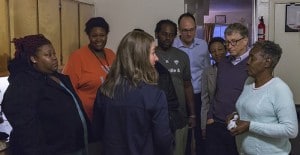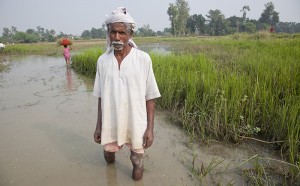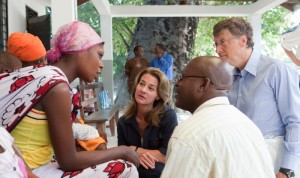Bill and Melinda Gates Foundation 10th Annual Letter:
We are outspoken about our optimism. These days, though, optimism seems to be in short supply. The headlines are filled with awful news. Every day brings a different story of political division, violence, or natural disaster. Despite the headlines, we see a world that’s getting better.
Compare today to the way things were a decade or a century ago. The world is healthier and safer than ever. The number of children who die every year has been cut in half since 1990 and keeps going down. The number of mothers who die has also dropped dramatically. So has extreme poverty—declining by nearly half in just 20 years. More children are attending school. The list goes on and on.
But being an optimist isn’t about knowing that life used to be worse. It’s about knowing how life can get better. And that’s what really fuels our optimism. Although we see a lot of disease and poverty in our work—and many other big problems that need to be solved—we also see the best of humanity. We spend our time learning from scientists who are inventing cutting-edge tools to cure disease. We talk to dedicated government leaders who are being creative about prioritizing the health and well-being of people around the world. And we meet brave and brilliant individuals all over the world who are imagining new ways to transform their communities.
That’s our response when people ask, “How can you be so optimistic?” It’s a question we’ve been getting more and more, and we think the answer says a lot about how we view the world.
This is our 10th Annual Letter, and we’re marking the occasion by answering 10 tough questions that people ask us. We will answer them as forthrightly as we can, and we hope that when you’re finished reading, you’ll be just as optimistic as we are.
Why don’t you give more in the United States?
Melinda: Our foundation spends about $500 million a year in the United States, most of it on education. That’s a lot, but it is less than the roughly $4 billion we spend to help developing countries.
We don’t compare different people’s suffering. All suffering is a terrible tragedy. We do, however, assess our ability to help prevent different kinds of suffering. When we studied the global health landscape, we realized that our resources could have a disproportionate impact. We knew we could help save literally millions of lives. So that’s what we’ve tried to do.
Take vaccines. We assumed that since it was possible to prevent disease for a few cents or a few dollars at most, it was being taken care of. But it turned out that we were wrong, and tens of millions of kids weren’t being immunized at all.
We’ve spent $15.3 billion on vaccines over the past 18 years. And it’s been a terrific investment. Better immunization is one reason why the number of children who die has gone down by so much, from almost 10 million in 2000 to 5 million last year. That’s 5 million families that didn’t have to suffer the trauma of losing a daughter or a son, a sister or a brother.
We love our country and care deeply about the people who live here, so we are also committed to fighting inequities in the United States. All the evidence, including our personal experience, suggests that education is the key to opportunity. By 2020, two-thirds of American jobs will require post-high school education or training. Since millions of American students don’t get a high-quality education, that’s the issue we’ve been focused on for the past 18 years. Our goal is for all students to go to a school that prepares them to pursue their dreams.

Bill: We’ve been looking at how we might expand our work in the U.S. beyond education. We fund the U.S. Partnership on Mobility from Poverty, which is studying ways to help people move up the economic ladder. Although we travel extensively to learn about the lives of poor people in other countries, we’ve done less of that in America. So last fall, we took a trip to the South to learn more.
In Atlanta, we met a single mom who told us a heartbreaking story about how she had just been evicted from her apartment for missing a rent payment while in the hospital with her newborn son. We had coffee with a few residents of an apartment complex in one of the city’s low-income neighborhoods. They showed us mold growing on the walls and ceiling of one of their homes. They told us they routinely hide their children under a bed or in the bathtub because of the sound of gunfire.
It would be an understatement to say the people we met in Atlanta faced big challenges. But they were also incredibly resilient. At a Boys and Girls Club, we met a man who uses his own money to buy lunch for the kids. We talked with former prison inmates who are now holding down jobs and raising families.
What we saw on this trip reinforced the importance of education, because it is ultimately about helping low-income students and students of color get the same opportunities as everyone else. The visit also made us think through other ways we could help people get out of poverty. The issues of economic mobility in America are deeply intertwined: education, employment, race, housing, mental health, incarceration, substance abuse. We haven’t decided how what we’ve been learning might affect our giving, but it has certainly had an effect on us. We will share more about our approach when we have settled on a strategy.
What do you have to show for the billions you’ve spent on U.S. education?
Bill: A lot, but not as much as either of us would like. We made education the focus of our work in the United States because it is the key to a prosperous future, for individuals and the country. Unfortunately, although there’s been some progress over the past decade, America’s public schools are still falling short on important metrics, especially college completion. And the statistics are even worse for disadvantaged students.
We support early learning and postsecondary institutions, but we started with high schools, and that’s still the area in which we invest the most. We’ve learned a lot about what works in education, but the challenge has been to replicate the successes widely.
In the early 2000s, our foundation was one of the organizations that drew attention to a big flaw in the way high-school graduation rates were calculated. They were often reported at 90 percent when they were actually less than 70 percent—that is, roughly a third of students were dropping out. We funded research that identified the true graduation rate and helped build a coalition of states that agreed to use it.
To help raise those graduation rates, we supported hundreds of new secondary schools. Many of them have better achievement and graduation rates than the ones they replaced or complemented. Early on, we also supported efforts to transform low-performing schools into better ones. This is one of the toughest challenges in education. One thing we learned is that it’s extremely hard to transform low-performing schools; overall they didn’t perform as well as newly created schools. We also helped the education sector learn more about what makes a school highly effective. Strong leadership, proven instructional practices, a healthy school culture, and high expectations are all key.
Melinda: We recently announced some changes in our education work that take these lessons into account. Everything we do in education begins as an idea that educators bring to us. They’re the ones who live and breathe this work, who have dedicated their careers to improving systems that are failing many students today, especially minority students.
That’s definitely true of our new strategy. We will work with networks of middle and high schools across the country to help them develop and implement their own strategies for overcoming the obstacles that keep students from succeeding. We will help these networks with the process: using key indicators of student success like grades and attendance to drive continuous learning and improvement. But the substance of the changes they make will depend on what local leaders and the available evidence say are most likely to be effective.
Some networks of schools will focus on approaches that we have a lot of experience with, like stronger curricula and teacher feedback systems. Others will look at areas that are new to us, like mentoring programs to ease the difficult transitions from middle to high school and high school to college. Our role will be to support the schools as they design changes, gather and analyze data, and make adjustments over time based on what they’re learning.

Why don’t you give money to fight climate change?
Bill: We do! Some of it involves our foundation, and some of it involves our own personal investments.
Personally, we’re investing in innovations that will cut back on greenhouse gases (what’s called climate-change mitigation). The world needs new sources of reliable, affordable clean energy, but it has been dramatically underfunding the research that would produce these breakthroughs.
This funding gap is different from the problems we work on at the foundation. In philanthropy, you look for problems that can’t be fixed by the market or governments. The clean-energy problem can be fixed by both—as long as governments fund basic research and create incentives to reduce greenhouse gas emissions and investors are patient while companies turn that research into marketable products. That’s why I’m working on it personally rather than through our foundation.
In the past two years, there’s been a lot of progress. Twenty-three countries have committed to doubling their investments in clean-energy research by 2020. Breakthrough Energy Ventures, a private investment fund I am involved with, now has more than $1 billion from a variety of investors and will fund companies in several areas (such as grid-scale storage and geothermal power) that are ripe for innovation. BEV will also be working with a coalition of other clean-energy investors to connect them with governments. Right now, public and private spending on clean energy isn’t coordinated, which is one reason some promising technologies don’t make it to market. We want to bridge that gap.
Melinda: Even breakthrough technology can’t stop the weather from changing. So the world needs to adapt to what’s happening now and what we know is coming. That’s why our foundation’s work, especially in global agriculture, is increasingly focused on climate issues.
Hundreds of millions of people in developing countries depend on farming for their livelihoods. They had almost nothing to do with causing climate change, but they will suffer the most from it. When extreme weather ruins their harvest, they won’t have food to eat that year. They won’t have income to spend on basic necessities like health care and school fees. For smallholder farmers, climate change is not just an ominous global trend. It is a daily emergency.
But just as innovation can limit climate change, it can also help people cope with it. We invest to help farmers be more productive, so that they’ll have more buffer to withstand lean years when they come. We also invest in climate-smart crops that are less susceptible to extreme heat and cold, drought and flooding, and diseases and pests. For example, we’re working with partners including the Chinese Academy of Agricultural Science to develop varieties of rice that tolerate drought and require less fertilizer, herbicide, and pesticide. Innovations like this “Green Super Rice” could be key to fighting poverty and feeding the world in the decades to come.

Are you imposing your values on other cultures?
Sometimes, though, the person asking this question is raising a deeper issue. It’s not so much a question about what we do, but how we do it. Do we really understand people’s needs? Are we working with people on the ground?
We have about 1,500 employees in offices on four continents who look at the data, survey the universe of possible approaches, study what’s worked and what hasn’t, and develop strategies that we believe will maximize our impact. But one of the most important parts of their job is to listen to partners, adjust the strategies based on what they hear, and give implementers the leeway to use their expertise and their local knowledge. That’s not to say we always get it right. We don’t. But we try to approach our work with humility about what we don’t know and the determination to learn from our mistakes.
On top of relying on local partners, we also have a strong conviction about the importance of empowerment. We aren’t interested in making choices for anyone. We invest in family planning, for example, not because we have a vision of what other people’s families should look like but because parents around the world have told us they want the tools to make their vision of their own family come to fruition. In all our work, we are interested in making sure people have the knowledge and power to make the best choices for themselves.
Does saving kids’ lives lead to overpopulation?
Melinda: We asked ourselves the same question at first. Hans Rosling, the brilliant and inspiring public health advocate who died last year, was great at answering it. I wrote about the issue at length in our 2014 letter. But it bears repeating, because it is so counterintuitive. When more children live past the age of 5, and when mothers can decide if and when to have children, population sizes don’t go up. They go down. Parents have fewer children when they’re confident those children will survive into adulthood. Big families are in some ways an insurance policy against the tragic likelihood of losing a son or a daughter.
We see this pattern throughout history. All over the world, when death rates among children go down, so do birth rates. It happened in France in the late 1700s. It happened in Germany in the late 1800s. Argentina in the 1910s, Brazil in the 1960s, Bangladesh in the 1980s.
When more children live, you get one generation that’s relatively big. Then, when families decide to have fewer children, the next generation is much smaller. Eventually, a country ends up with relatively more people in the labor force producing economically—and relatively fewer dependents (very old or very young people). That’s a recipe for rapid economic development, especially if countries take advantage of it by investing in health and education.
Fortunately, the number of child deaths is likely to keep going down. The rate of innovation in child health is extraordinary, and the world is starting to make progress on some of the most stubborn challenges in the field. For example, we now know that malnutrition is a contributing factor in half of all child deaths, but there are still many open questions about what causes malnutrition and how to prevent it. One promising area is the study of the microbiome—all the bacteria in the human gut—and the role it plays in kids’ ability to absorb nutrients. We’re also working with a partner on a device that’s the thickness of a piece of string that can go down infants’ noses and take 360-degree microscopic pictures of the gut. Soon, we’ll be able to see how a child is developing, instead of having to guess.

Leave A Comment
You must be logged in to post a comment.